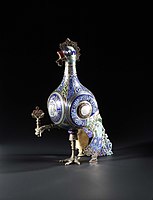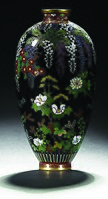
Vitreous enamel, also called porcelain enamel, is a material made by fusing powdered glass to a substrate by firing, usually between 750 and 850 °C. The powder melts, flows, and then hardens to a smooth, durable vitreous coating. The word vitreous comes from the Latin vitreus, meaning "glassy".

In art history, the French term objet d’art describes an ornamental work of art, and the term objets d’art describes a range of works of art, usually small and three-dimensional, made of high-quality materials, and a finely-rendered finish that emphasises the aesthetics of the artefact. Artists create and produce objets d’art in the fields of the decorative arts and metalwork, porcelain and vitreous enamel; figurines, plaquettes, and engraved gems; ivory carvings and semi-precious hardstone carvings; tapestries, antiques, and antiquities; and books with fine bookbinding.

Cloisonné is an ancient technique for decorating metalwork objects with colored material held in place or separated by metal strips or wire, normally of gold. In recent centuries, vitreous enamel has been used, but inlays of cut gemstones, glass and other materials were also used during older periods; indeed cloisonné enamel very probably began as an easier imitation of cloisonné work using gems. The resulting objects can also be called cloisonné. The decoration is formed by first adding compartments to the metal object by soldering or affixing silver or gold as wires or thin strips placed on their edges. These remain visible in the finished piece, separating the different compartments of the enamel or inlays, which are often of several colors. Cloisonné enamel objects are worked on with enamel powder made into a paste, which then needs to be fired in a kiln. If gemstones or colored glass are used, the pieces need to be cut or ground into the shape of each cloison.
A Fabergé workmaster was a skilled craftsman who owned his own workshop and produced jewelry, silver or objets d'art for the House of Fabergé.

The Red Cross with Imperial portraits egg is a jewelled and enameled Easter egg made by Henrik Wigström (1862–1923) under the supervision of the Russian jeweller Peter Carl Fabergé in 1915, for Nicholas II of Russia, who presented the Fabergé egg to his mother, the Dowager Empress Maria Feodorovna, in the same year.
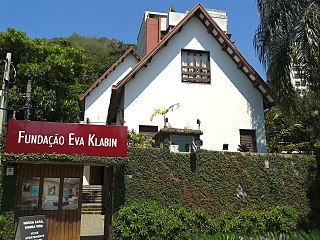
The Eva Klabin House Museum is an historic house museum located in the city of Rio de Janeiro, Brazil. It is a private institution established in 1990 by the Brazilian collector and philanthropist Eva Klabin (1903–1991), with the purpose of preserving and displaying the art collection gathered together during her life. The collection is open to the public in the house where Klabin lived for over thirty years. It is considered one of the largest classical art collections in Brazilian museums, with over 2000 works spanning almost 5000 years, from Ancient Egypt to Impressionism.
Ando Cloisonné Company is a Japanese cloisonné making company located in Sakae, Nagoya, central Japan.
Namikawa Sōsuke (1847–1910) was a Japanese cloisonné artist, known for innovations that developed cloisonné enamel into an artistic medium sharing many features with paintings. He and Namikawa Yasuyuki were the most famous cloisonné artists of the 1890 to 1910 period, known as the "golden age" of Japanese enamels. Around 1880 he set up and ran the Tokyo branch of the Nagoya Cloisonné Company. He exhibited his artworks at national and international expositions, where he took an organising role. He was recognised as an Imperial Household Artist and created art works for imperial residences. He sometimes signed his works with the character sakigake (pioneer).

Namikawa Yasuyuki (1845–1927) — original family name Takaoka — was a Japanese cloisonné artist. His work was highly sought after in his own lifetime and is held in several collections today. He and Namikawa Sōsuke were the most famous cloisonné artists of the 1890 to 1910 period, known as the "Golden age" of Japanese enamels. From 1875 to 1915, he won prizes at 51 exhibitions, including at world's fairs and at Japan's National Industrial Exhibition. For his work he was appointed an Imperial Household Artist in 1896. He sometimes signed his pieces Kyoto Namikawa.

Hattori Tadasaburō (服部唯三郎) was a Japanese cloisonné artist from Nagoya.
Kawade Shibatarō was a Japanese artist working in shippo. As head of the Ando Cloisonné Company, he introduced a number of technical innovations, expanding the colours that could be rendered in enamel and bringing the company to a new level of success. Under his leadership, the company exhibited at world's fairs, winning multiple awards. It was also appointed as an official supplier of cloisonné works for the Japanese imperial family.
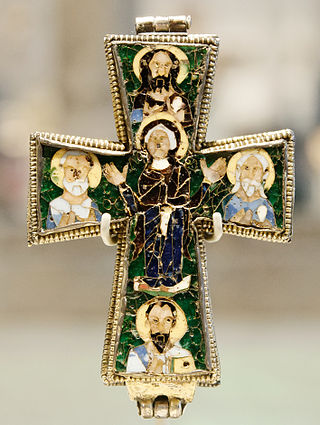
The craft of cloisonné enameling is a metal and glass-working tradition practiced in the Byzantine Empire from the 6th to the 12th century AD. The Byzantines perfected an intricate form of vitreous enameling, allowing the illustration of small, detailed, iconographic portraits.

The Khalili Collections are eight distinct art collections assembled by Nasser D. Khalili over five decades. Together, the collections include some 35,000 works of art, and each is considered among the most important in its field.
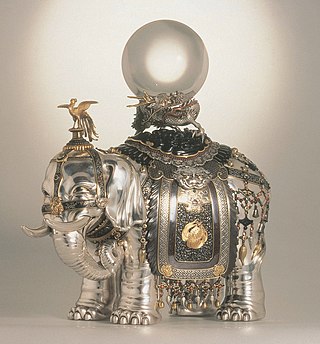
The Khalili Collection of Japanese Art is a private collection of decorative art from Meiji-era (1868–1912) Japan, assembled by the British-Iranian scholar, collector and philanthropist Nasser D. Khalili. Its 1,400 art works include metalwork, enamels, ceramics, lacquered objects, and textile art, making it comparable only to the collection of the Japanese imperial family in terms of size and quality. The Meiji era was a time when Japan absorbed some Western cultural influences and used international events to promote its art, which became very influential in Europe. Rather than covering the whole range of Meiji-era decorative art, Khalili has focused on objects of the highest technical and artistic quality. Some of the works were made by artists of the imperial court for the Great Exhibitions of the late 19th century. The collection is one of eight assembled, published, and exhibited by Khalili.

The Khalili Imperial Garniture is a trio of cloisonné vases created for a Japanese Imperial commission during the Meiji era. The items were exhibited at the World's Columbian Exposition in Chicago, United States, in 1893, where they were described as "the largest examples of cloisonné enamel ever made". The decoration of the vases represents virtues and the seasons, and also has an allegorical meaning about Japan's role in a changing world and its alliance with the United States. After being exhibited, the vases were separated from each other for more than 120 years, eventually reunited in 2019 in the Khalili Collection of Japanese Art, a private collection assembled by the British-Iranian collector and scholar Nasser D. Khalili.

Plácido Maria Martin Zuloaga y Zuloaga was a Spanish sculptor and metalworker. He is known for refining damascening, a technique that involves inlaying gold, silver, and other metals into an iron surface, creating an intricate decorative effect. Zuloaga came from a family of Basque metalworkers. He was the son of damascening pioneer Eusebio Zuloaga, the half-brother of the artist Daniel Zuloaga, and the father of the painter Ignacio Zuloaga. Taking over his father's armaments factory, he adapted it to make art pieces which he exhibited at international fairs, winning multiple awards.
Yabu Meizan was a Japanese artist and workshop owner known for painting on porcelain. His studio produced high-end Satsuma ware, primarily for the export market. That term was originally coined for artistic painted porcelain from the Satsuma Province. Eventually it expanded to include low-quality porcelain that was mass-produced for export, whereas Meizan was one of the artists who continued the tradition of high artistic quality while also successfully exporting. He is regarded as the "prince" of this medium and today his works are sought after by collectors.

The Khalili Collection of Spanish Damascene Metalwork is a private collection assembled by the British-Iranian scholar, collector and philanthropist Nasser D. Khalili. It includes a hundred examples of damascened metalwork, in which gold or silver is pressed into an iron surface to create fine decoration. It is one of eight collections assembled, conserved, published and exhibited by Khalili, each of which is considered among the most important in its field. The collection includes art works from 1850 to the early twentieth century, including many from the workshop of Plácido Zuloaga and other works from artists trained or influenced by Zuloaga. Almost all the works are from Eibar or Toledo.
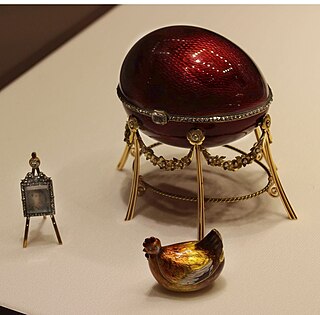
The Kelch Hen egg is a jewelled, enameled Easter egg that was made in St. Petersburg between 1898 and 1903 under the supervision of Michael Perkhin, on behalf of the Russian jeweler Peter Carl Fabergé. It was made for the Russian industrialist Alexander Ferdinandovich Kelch, who presented the egg to his wife, Barbara Kelch-Bazanova. It is thought to be the first of the seven eggs that, every year from 1898 to 1904, were ordered by Alexander Kelch and made by Michael Perkhin, Fabergé master goldsmith at the time, frequently inspired by the imperial eggs.

The Nasser D. Khalili Collection of Islamic Art includes 28,000 objects documenting Islamic art over a period of almost 1400 years, from 700 AD to the end of the twentieth century. It is the largest of the Khalili Collections: eight collections assembled, conserved, published and exhibited by the British-Iranian scholar, collector and philanthropist Nasser David Khalili, each of which is considered among the most important in its field. Khalili's collection is one of the most comprehensive Islamic art collections in the world and the largest in private hands.









